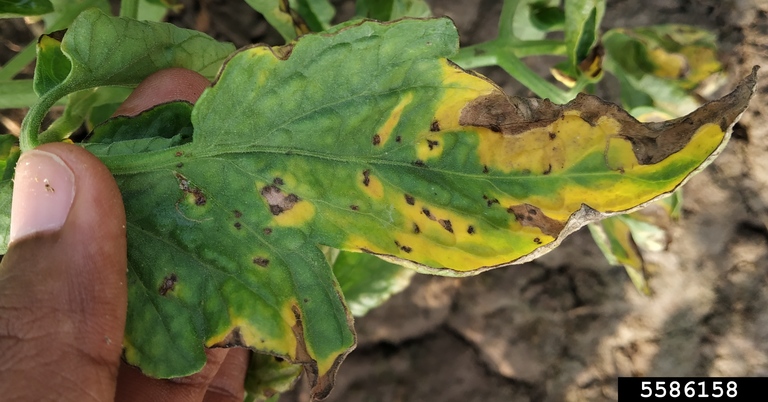
Septoria blight is fungal disease caused by Septoria lycopersici and primarily affects tomatoes but can also infect other members of the nightshade family such as potato and eggplant. The main source of the fungus each year is plant debris from diseased plants that overwinter in the soil. The fungus thrives in warm, wet, humid conditions and is quickly spread by wind, splashing water, tools, insects, and humans. Photo Credit Dr Parthasarathy Seethapath Wikipedia
The fungus can infect the plants at any stage of development but usually first affects the lower leaves and stem during fruit set and spreads upwards. The symptoms appear on the lower leaf surfaces as circular, water-soaked, brown to black spots with a light gray or tan center. Many dark-brown, pimple-like structures appear within the tan centers and are the diagnostic feature of Septoria blight. As leaves are infected, they turn yellow, die, and drop and if leaf drop is severe enough it may result in stunted plants and smaller fruit (due to decreased photosynthesis), as well as sunscalding of the fruit.
Control
- Remove infected plants immediately and dispose of them to reduce the spread of the fungus. Wash tools, hands, and clothing that may carry the disease.
- Crop rotation every 3 years with crops from other plant families
- Remove and dispose of above ground crop residue
- Water in the morning using drip irrigation to reduce the time that moisture is on the leaves
- Mulch plants to reduce the effects of rain splashing spores onto plants
- Increase air circulation by increasing space between plants or trimming excess foliage
- Spray with a solution of 1 tablespoon baking soda, 2 1/2 tablespoons vegetable oil, and 1 teaspoon of liquid soap (not detergent) per gal of water. Repeat every 2 weeks, more often if rain washes the solution away.
- Spray with a prepared solution of Bacillus subtilis about every 2 weeks or when rain has washed it off the leaves.
- For very severe infestations spray with copper or sulfur, heeding cautionary warnings on the containers. These are more demanding solutions to the problem and the copper application will require special equipment.